Unfortunately we've got one more year before the Dots truly shifted their focus to LPs, but 1982 would at least see the official release of their first one...
...but it didn't happen right away. The Dots did hook up with Pat Bermingham's In Phaze Records to release a six-track cassette named after one of their more recent songs, the melodic but unsuccessful ballad "Brighter Now." The cassette did not include the title track but instead featured six tracks that had developed since their appearance on Chemical Playschool Volumes 1 & 2, including a reprise of the excellent "Legacy" that had been given prime placement on Kleine Kreig. Later in the year In Phaze would partner with New European Recordings to bring this material in slightly remixed form to LP, and in order to pad out the length, the Dots added three tracks.
[Discography note: Presumably by the time of the LP release, at least two of the other 1982 cassettes had been assembled if not released. Based on the appearance of particular songs, the Brighter Now cassette seems to clear the deck of some of the holdovers from earlier tapes whereas the other 1982 releases feature all-new material.]
Brighter Now
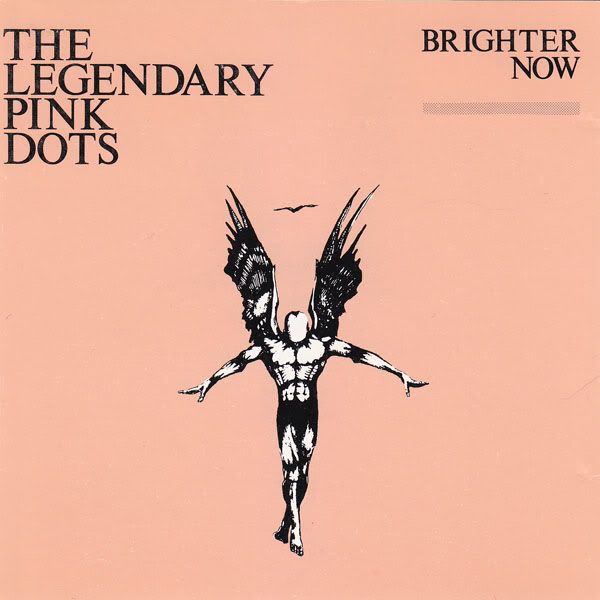
Front cover of vinyl reissue and first CD edition on Terminal Kaleidoscope

Back cover of vinyl reissue (above) and CD edition (below)
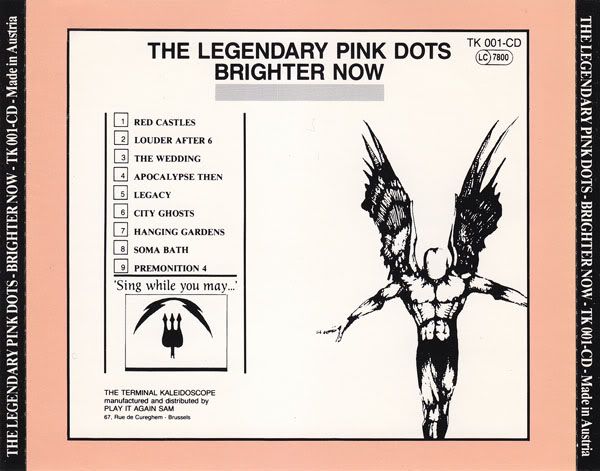
*These 6 tracks were on the original cassette edition of Brighter Now.
On their debut album, the Dots come across as song-oriented and gentle. Much of the experimentation littered throughout their early cassettes has been excised here, leaving at least half of the material to focus strictly on Edward Ka-Spel's voice with musical backing that applied an unexpected amount of restraint to a baroque variety of sounds and instruments. There is absolutely no doubt that the Dots are attempting to be commercial here, though the recordings are still painfully lo-fi and in some cases badly produced, meaning that a band that worked with synthesizers and electronics would already sound dated by the time of the record's release. In other words, this was not going to be able to compete with the likes of Depeche Mode or the Human League, and the band certainly must have known this. Of course, this is a major part of the record's charm.
Along with the shift in sound, the band started to develop a mythology of its own. The cover image of the winged man descending from the heavens, which is more distinctly illustrated on the cassette, is no accident, as it immediately calls to mind everything from Icarus to Flash Gordon to the Bible. Brighter Now is the album that accentuates the band's roots in hippie folk rock, '70s prog, science fiction, fantasy, and fairy tales. Characters who were once bored office workers or bohemian artists were now drawn as knights, maidens, princesses, and magicians. But instead of living happily ever after, these folks were hung for crimes they didn't do, mourned for the loss of their loved ones, and revolted in dystopian societies that tapped their phones. Underneath these gentle pop songs, with their choral backdrops, acoustic guitars, and Casio keyboard presets, an apocalyptic vision was beginning to evolve.
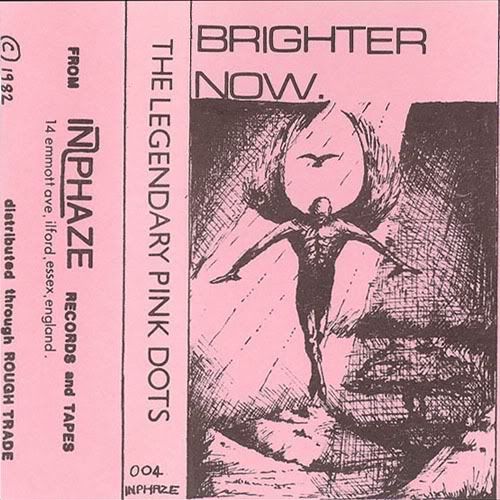
In Phaze cassette exterior (above) and interior (below)
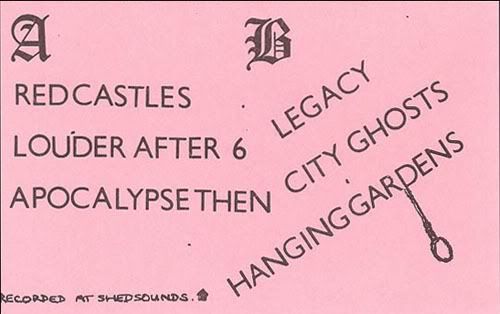
"Red Castles" is an odd way to start the album, as it's one of the dinkiest sounding songs on the record. But I suppose in an alternate universe where the Legendary Pink Dots were eligible for chart success, if a song were to have been designated as a single, this might have been it. The song is especially catchy and it does a great job of establishing what the band is about thematically, as it immediately draws a parallel between the Dots' fantasy world and real life scenarios such as bar fighting and seeing a therapist. The central message seems to take on the self-help movement, where visualization exercises can help a person overcome obstacles: "You are king of the castle. Your glory excels in here." The chorus includes transcendent background vocals, but otherwise the song is brittle sounding, especially the drums. "Louder After 6" follows, and it wins the award for most improved, as it was the song on Ancient Daze that was so overheated with chirpy synth sounds that it was rendered unlistenable. Here, it is a much smoother affair, with a swinging rhythm and soft, outdated keyboards that make it sound like something you'd hear at an organ demonstration in a mall music shop circa 1979. In fact, the song is now such a harmless pop song that it is somewhat unremarkable, though the numerous phone effects at the end act as a true reminder which band this is. "The Wedding" reappears next, and it is still a heartfelt ballad, somewhat polished up and played on a real piano this time. It is a nice song with a typical Ka-Spel twist; the protagonist is marrying but feels insincere about it, and this is his inner monologue throughout the ceremony. "Maybe someday the rewards wil be there in Heaven just for us." Amen, indeed.
"Apocalypse Then" is much more interesting than I have ever given it credit for. It describes a wartime panic scenario where everyone thinks the world is ending, but it is presented in a four-part structure that feels unified and never loses focus over seven and a half minutes. In fact, it continues to build dramatically. After a narrated intro, the song features an extremely lovely middle passage with harmony vocals (courtesy Ka-Spel and guitarist Mick Marshall) and fingered guitar, then builds to an intense climax where, "You cannot keep this country down for long because we win so many fucking (wars)." It ends with a rallying crowd and the sound of a far-off belltower, achieving something cinematic that the band hasn't really tried before. The general sound of the track is a denser sound, almost rock, that doesn't rely as much on production gimmicks and therefore anticipates the direction the band would follow for the next four years.
"Legacy" (from Kleine Krieg) appears in a lush version next, kicking off the second half of the album, and it remains a standout of the oeuvre. This is followed by an update of "City Ghosts," again a trippy folk rock track with a memorably exotic sound courtesy of Keith Thompson's percussion, Roland Callaway's snake-charming bass, and Mick Marshall's Spanish-tinged guitar. Actually hearing audible contributions from all members of the band is a welcome change of pace after so many lo-fi cassettes, and at this point, the song is certainly an album centerpiece. Though its innocent pagan/hippie sound really dates it, "City Ghosts" ends up as one of the more adventurous pieces on the album, featuring a bridge underscored by percolating synths and moments of true progressive beauty. Better yet it segues directly into "Hanging Gardens," an absolutely stunning monster of a track and the sound of a band finally reaching artistic triumph. Again, the song is gentle, but its combination of ethereal synth washes, light acoustic guitar, and ever-so-slightly vocoded singing makes for irresistible atmosphere. The prettiness of the song obscures the ugliness of the lyrics, which could be about a woman with royal power who is either unable or unwilling to save her lover from a death sentence. But what knocks this track out of the ballpark is the fact that, led by a hypnotically dubby bassline, it suddenly reverses direction two-thirds of the way through.
Listen to "Hanging Gardens" here:
The album ends with an encore of "Soma Bath," apparently unchanged from its form on Kleine Krieg, which neither detracts or adds to the overall feel of the album, and finally a moody experimental track called "Premonition 4." This is the only instrumental track on the album, and after a brief moment where a girl sings "Ring Around the Rosie," it basically sounds like a 45 RPM record being played at 16 RPM so that the slow rhythm of the drum and bass fills the sound spectrum with darkness. It's a nice finishing touch to the record, if not overwhelmingly memorable. Other artists would stretch this out over 20 minutes, but the Dots know how to be economical when they have to be.
Brighter Now gained wider distribution in the late '80s when it was reissued on the band's own label and distributed by Play It Again Sam, a Belgian company that would play a major part in breaking the band internationally. However, it did not receive an official U.S. release until 1996, when it was reissued by Soleilmoon Recordings and given terrible new (goth) cover art, as seen below.

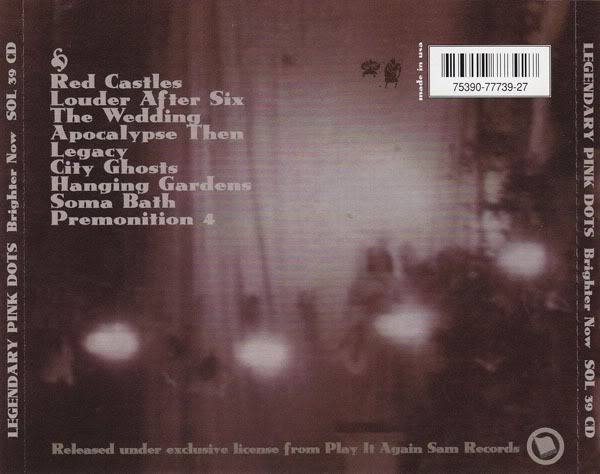

<----- GO BACKWARD to Atomic Roses and Apparition

1 comment:
sadly, i am most familiar with the "goth" cover art. go figure.
Post a Comment